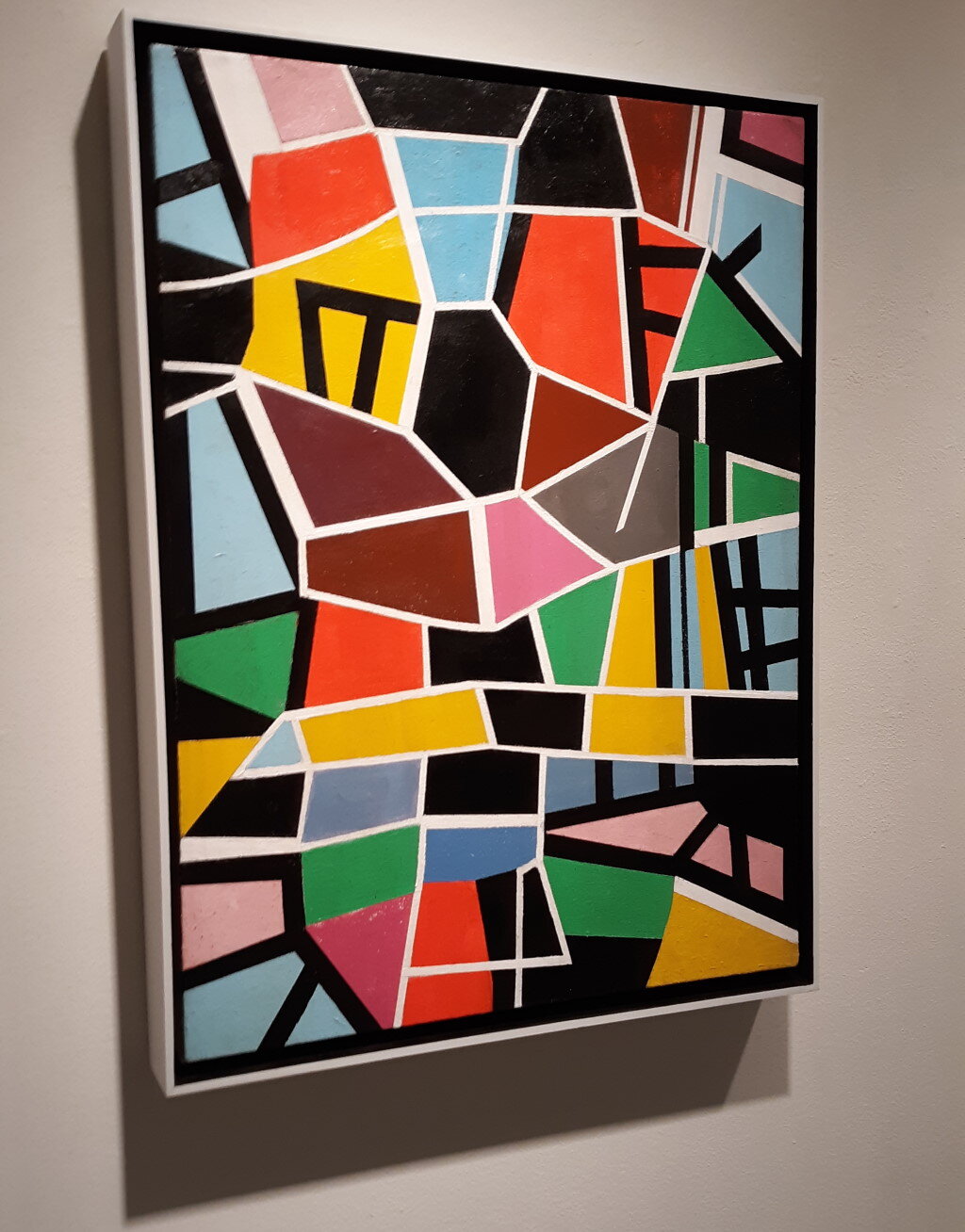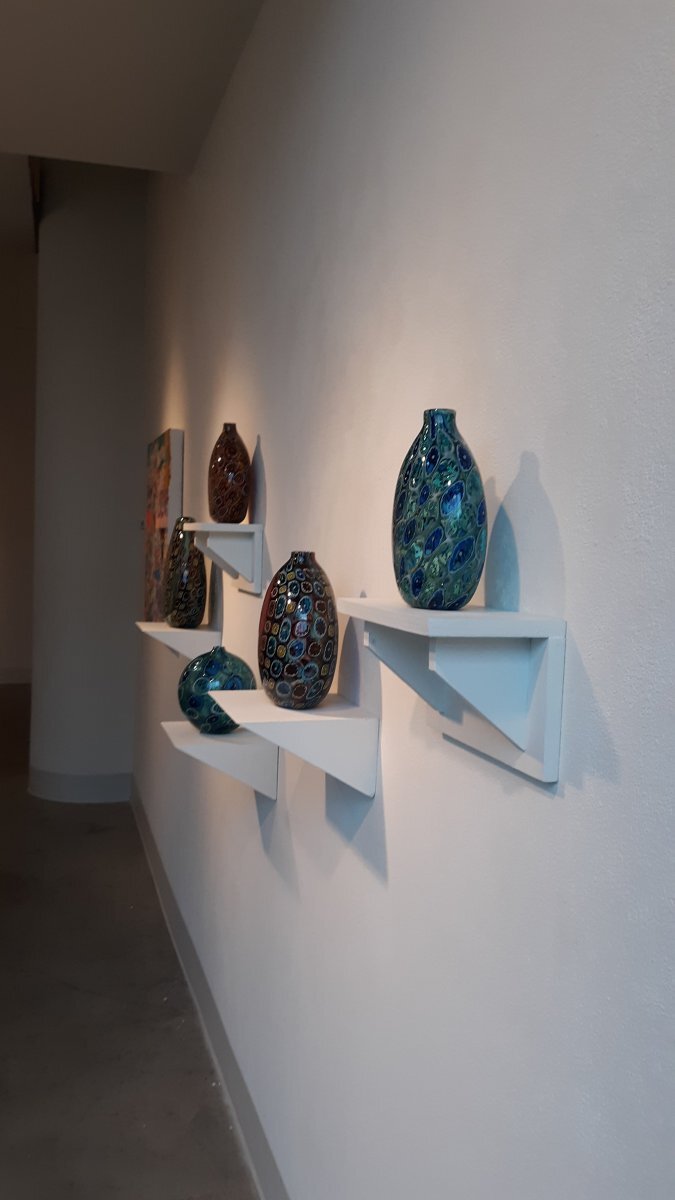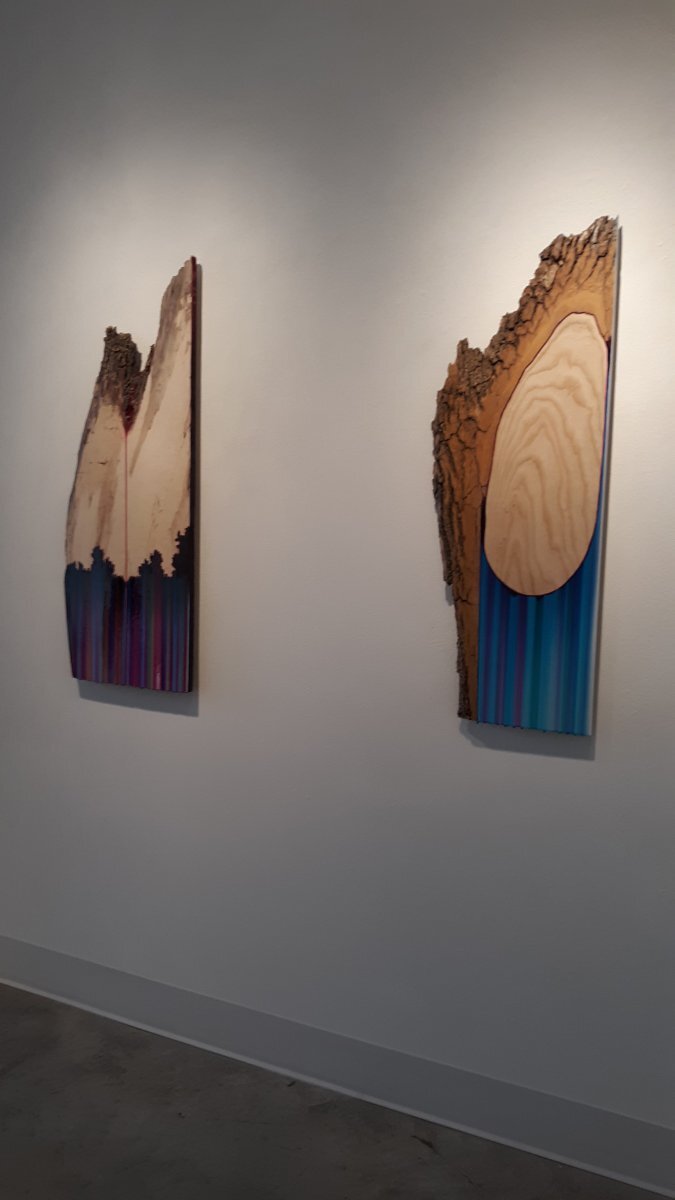Jeremy Popelka Ventures to Thailand to share is skills in glass
Read MoreUrban Milwaukee Reviews CHROMA
*To read the original article on the Urban Milwaukee website, please click HERE
Oh So Many Colors
From the CHROMA exhibit. Photo by Catherine Jozwik.
By Catherine Jozwik - Jan 8th, 2020 03:42 pm
The Tory Folliard Gallery’s current exhibition, CHROMA, features the works of 10 artists who favor brilliant hues, who explore the fascinating relationships between colors and their powerful impact on art.
“Color serves as an open-ended question for a number of artists. A recent renewed interest in color is evidenced by a number of new books on the subject being published,” UW-Madison Professor of Art Derrick Buisch is quoted in the show’s description. “Color is a favorite topic of articles, as its history opens up tales of the fantastic nature of pigments.”
On display through February 8, CHROMA showcases the paintings of Buisch, Terrence Coffman, Ben Grant, Michael Hedges, Shane McAdams, Clarence Morgan, Jason Rohlf, and T.L. Solien, along with aluminum sculptures by Richard Taylor and glassworks by Jeremy Popelka.
Representing every color under the spectrum, from warm golds and oranges to shocking pinks and soothing greens to cool blues and royal purples, CHROMA is a treat for the eyes. Visiting the exhibition is an especially appealing excursion on a gray winter day (like the somber Saturday when this writer visited the gallery).
Most of the works, including those of Solien, who describes himself as an artist of the “absurdist cultural critique,” Rohlf’s meditative collage-based paintings, Coffman’s richly-layered landscapes, and Hedges’ experimentations with form and texture, are abstracted and utilize geometric shapes; notably, triangles and spirals. Solien’s “Nimrod’s Path” and “Man on Path” brings to mind stained-glass windows and kaleidoscopes. With interlocking shapes and lines reminiscent of maps, Morgan’s graphite, watercolor, and ink drawings capture the nature of fleeting thoughts and social and political upheaval, while Buisch’s graphic-inspired “monster” drawings, outlined in light colors, pop against bold blue and bright orange backgrounds.
Several artists employ unexpected media in their works, with dazzling results. For example, McAdams’ paintings, thin stripes of vibrant colors set against pieces of tree stumps, were created using the ink of ballpoint pens. Grant’s “Untitled #300,” (acrylic, automotive paint, ball point pen, colored pencil, enamel, graphite, oil, and spray paint on canvas) is hypnotic.
The exhibit is rounded out by works from Taylor and Popelka. Taylor’s lively “Golden 1” and “Golden 4” sculptures depict a female and a male figure standing atop a series of multicolored blocks of various sizes, works which pay homage to the sculptor’s love of music, poetry and travel. Popelka’s breathtaking glass vases were blown using Murrini (an ancient Middle Eastern technique revived by 16h century Venetian glassmakers on Murrano, often resulting in a mosaic-like effect). “In the impressive body of work created for CHROMA, he explores new patterns inspired by ancient textiles and revisits Venetian favorites,” reads a gallery press release.
“Color is a constant and continuous conversation among artists, a subject that very quickly transcends its rote charts and color wheels to become a force, a driver, a motivator, an endless riddle, and for some, a clear obsession,” Buisch said. “Since the Bauhaus, color continues to be a staple among art school foundation curriculums. This entry-level position in serious art education does not belie the depth that the subject can run for artists.”
Jeremy Popelka and Jason Rohlf Exhibitions Reviewed in the Shepherd Express
Jason Rohlf’s paintings are abstract, yet conjure ideas of maps or stories. In the exhibition “Kismet,” on view at Tory Folliard Gallery, endless rings of circles, rows of arches, hanging diamonds and more play out in bright acrylic colors, sometimes painted on the relatively modest materials of shop rags or tarps.
New sculptures by Jeremy Popelka in his exhibition “Gravity” are also on view, and it is a good pairing as his figurative pieces share this type of synthesis. Inspired by his recent time in Thailand, Popelka fashions masks out of glass, incorporating textured surfaces that reference symbolic concepts.
Read MoreJeremy Popelka and Stephanie Trenchard Featured on the Wisconsin Academy of Sciences, Arts, & Letters
An iron casting ladle, steel blowpipes, and oversize shears rest just steps away from the work stations where Sturgeon Bay artists Jeremy Popelka and Stephanie Trenchard transform molten glass into sometimes practical, sometimes whimsical works of art.
Read MoreCHROMA is Art City Gallery Night Pick - January, 2015
"For a middle-of-winter rush of color, this show will feature seven abstract artists who use color with abandon and conceptual subtlety. The artists include Tom Berenz, Derrick Buisch, Ben Grant, Mark Ottens, Jeremy Popelka, Jason Rohlf and Richard Taylor."Read More
CHROMA featured in Milwaukee Magazine - January, 2015
The exhibition CHROMA was featured as a "Best Bet" in Milwaukee Magazine's January issue. Here is what editor Clare Hanan had to say:
Tom Berenz, GARDEN ABOVE THE LAKE, Acrylic, Oil, and Spray Paint on Canvas, 60 x 72"
Color Rush
Bright, permeating and myriad colors can often be curative in an oppressively cold environment. This month, works of all shades fill Tory Folliard Gallery, including those of metal sculptor Richard Taylor, along with Jason Rohlf’s geometric, dizzying acrylic paintings and Derrick Buisch’s oil abstractions. Jeremy Popelka’s amoeba-like glass sculptures will provoke and perplex. And Mark Ottens’ multilayered, psychedelic paintings will offer a study in painstaking self-discipline. Collectively, it’s a remedy with just enough burn to get those neurons firing again. (Claire Hanan)
➞ Chroma (Jan. 9-Feb. 28). Tory Folliard Gallery. 233 N. Milwaukee St., 414-273-7311, toryfolliard.com.
Forward 2014 - A Survey of WI Art through June, 2014
Every two years, the Charles Allis Art Museum hosts Forward: A Survey of Wisconsin Art Now, a juried exhibition showcasing the work of Wisconsin artists. Laurie Winters, Executive Director | CEO of the Museum of Wisconsin Art is this year's juror. Tory Folliard Gallery artists participating in the show are: Craig Blietz, Terrence Coffman, Jeremy Popelka, and Stephanie Trenchard.
Read MoreForward 2014: A Survey of Wisconsin Art through June 2014
Every two years, the Charles Allis Art Museum hosts Forward 2014: A Survey of Wisconsin Art Now, a juried exhibition showcasing the work of Wisconsin artists. Laurie Winters, Executive Director | CEO of the Museum of Wisconsin Art is this year's juror.
Read MoreJeremy Popelka - Sand Cast Glass Process - January, 2014
Like much of my other cast glass sculptures this body of work is inspired by observation of natural forms and processes. After a series of sketches and investigations, a wood mold is created and then often deconstructed. The separate elements are then cast in glass sections and then once cooled assembled back into different forms. Making the work in sections has allowed me to imply a sort of skeletal infrastructure to the whole form as well as entertain an adolescent conceit to putting the puzzle back together again. In addition “Veiled Monuments” is a group of objects tied together as artifacts that allude to a personal interpretation of the forces that hold the Universe together.
Jeremy begins the process by making wooden forms.
Jeremy Popelka pouring glass into a sand mold at Pilchuk in 2005, photo courtesy of the Seattle Times.
Some of the pieces allude directly to mathematical equations and their uses in architecture . “Catena”, for example, is the Latin root of Catenary which refers to the curve created when hanging a link chain from two points and observing the shape it creates. It literally refers to the links of a chain and how it represents the founding fathers connected creating one complete legacy in a literal form. Structurally a very strong form, a Catenarian curve has been utilized for centuries in structures and buildings. At the same time its utilitarian origins seem to be derived from a natural form vaguely recognizable. It is an example of how a mythological human historical overview, can be represented in an equation. Often the calculations and examples in the natural world were linked to the idea that the clarity of the answer to an equation was confirmation of a divine origin.
CATENA, Assembled Sand Cast Glass, 24 x 15 x 4"
Sand Mold section for COLLIDER right before being poured. The powder is ground glass and used as pigment.
Collider is titled literally after the particle accelerators that are well known in Chicago and Switzerland. The Cern collider in Switzerland, is a dramatic unprecedented apparatus that is stunning visually and may reveal the underlying structures of the Universe that have evaded physicists for millennia. The cylindrical form that is presented in “Collider” is relatively flat and projects an optical illusion of depth and volume. The curving of a flat form that projects three-dimensional shapes can in some ways be related to how light is bent by gravity. Ultimately, this piece is about the vessel and how glass becomes a container to hold and define light.
COLLIDER, Assembled Sand Cast Glass and Steel, 36 x 19 x 12"
GIBBOUS plywood molds.
The title “Gibbous” refers directly to a specific phase of the moon. I have investigated historical astronomy and how devices were created to chronicle the phases of the moon and other heavenly bodies. The ability for mankind to predict such things as the return of a comet or an upcoming eclipse was a monumental achievement that helped establish the Age of Enlightenment. My work has blue objects that in different light project different phases like the moon.
GIBBOUS, Assembled Sand Cast Glass, 17 x 10 x 3 1/2"
Center section of Core after pouring into sand mold.
CORE, Assembled Sand Cast Glass, 19 x 12 x 6"
These descriptions of my work help to offer a glimpse into my artistic process and my approach to conceptualizing and executing my work. My naïve take on science and its history is a tactic to glean imagery and ideas for forms that act as artifact to this methodology. The title “Veiled Monuments” is intentionally ambiguous like the answer to every piece of arts ultimate meaning.
Jeremy Popelka Art Review - January, 2014
Molecular Mysteries: Jeremy Popelka’s Sculptures
by Peggy Sue Dunigan for Door County Today
In a new body of sculpture created exclusively for the exhibition “Veiled Monuments,” Sturgeon Bay artist Jeremy Popelka is displaying his compelling artworks at Milwaukee’s Tory Folliard Gallery. His eight pieces play with scale and proportion to consciously “blow up” or explode images inspired by the delicate microorganisms and forms that delineate the beginnings of life on the molecular level.
Read More














